To maximize your off-grid cooking storage while moving, focus on stackable and collapsible equipment that serves multiple purposes. Choose magnetic utensil sets, nesting cookware, and compact solar ovens that break down flat. You'll want to protect your gear with moisture-resistant wraps and maintain organization using clear, uniform containers. Install vertical storage solutions like magnetic strips and fold-away shelving to optimize limited space. Keep frequently used items easily accessible and store backup equipment separately. Proper maintenance with vinegar solutions and protective oils will guarantee your mobile kitchen stays functional. There's much more to discover about efficient off-grid cooking setups.
Essential Solar Cooking Equipment
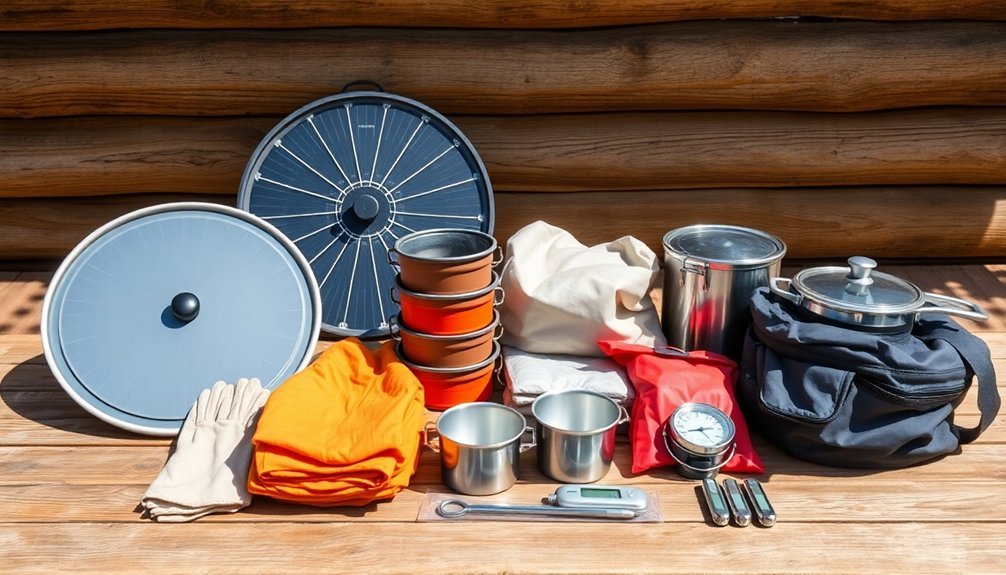
When planning your off-grid solar cooking setup, you'll need several fundamental components to create an effective cooking system.
Start with a lightweight cooking chamber, such as a cardboard pizza box or compact solar oven casing. You'll want reflective surfaces made from aluminum foil to direct and concentrate sunlight into your cooking area. Prop open flaps periodically to ensure maximum sunlight exposure throughout cooking sessions.
Include clear plastic wrap or glazed surfaces to trap heat effectively, and add black construction paper to absorb maximum thermal energy.
Don't forget insulating materials like newspapers to maintain consistent temperatures. For durability, consider models with borosilicate glass and stainless steel construction.
Look for features like stabilizer stands and cleaning brushes to make your setup more practical. Choose equipment that's both portable and sturdy – ideally weighing around 2 pounds with impact-resistant casing for easy transport.
Space-Saving Storage Solutions
In your off-grid kitchen, you'll want to maximize every inch of space with stackable containers that keep ingredients fresh while fitting neatly into compact areas.
Your vertical organization can include wall-mounted hooks, magnetic strips, and adjustable shelves to store cooking equipment without consuming precious counter space. Consider adding rotating corner shelves to maximize accessibility in tight spaces.
Investing in collapsible equipment like measuring cups, colanders, and storage bins lets you maintain essential tools while minimizing their footprint when not in use.
Stackable Containers Save Space
Space optimization becomes second nature with stackable containers in your off-grid kitchen. You'll maximize vertical storage while keeping your pantry staples organized and easily accessible.
Clear containers let you quickly identify contents at a glance, preventing waste and making inventory checks effortless.
To get the most from your stackable system, opt for uniform containers that fit together seamlessly. Label each container clearly, and arrange them by category – keeping baking supplies together, grains in one section, and snacks in another. Your sustainable living space can be enhanced by incorporating these efficient storage solutions, aligning with The Hideaway's eco-friendly design principles.
Since space is premium in off-grid living, these containers help you maintain order while storing more in less space. Remember to place frequently used items at eye level and seasonal ingredients in higher stacks, ensuring your daily cooking routine stays efficient and frustration-free.
Vertical Organization Methods
Maximizing vertical space transforms your off-grid kitchen into an efficient storage powerhouse.
You'll find endless possibilities by installing high wall shelves for seldom-used items like cake stands and seasonal cookware. Mount floating shelves to store daily essentials without consuming precious counter space.
Don't overlook the inside of cabinet doors – they're perfect for magnetic strips that hold metal utensils and knives. Add hooks for pot lids and cutting boards, while ceiling-mounted baskets can store produce.
Install pull-out shelves in lower cabinets to access items at the back easily.
Make use of narrow spaces by utilizing window sills and cabinet tops. Choose stylish wooden or metal-framed vertical shelves that complement your kitchen's aesthetic while keeping everything organized and within reach.
Collapsible Equipment Storage
Clever organization begins with collapsible storage solutions that adapt to your off-grid kitchen's changing needs.
You'll find weather-resistant storage options that protect your cooking equipment while maximizing limited space. From foldable boxes to portable mesh bags, these solutions let you quickly pack up and move your kitchen setup.
Choose from these versatile storage options:
- Mesh bags with clear handles for easy visibility of cooking utensils
- UV-resistant foldable boxes that double as prep surfaces
- Lightweight duffels with waterproof coating for protecting dry goods
- Collapsible equipment carts with lockable features for secure transport
- Multi-purpose storage containers that stack when in use and fold flat when empty
These space-saving solutions offer durability and quick assembly, making them perfect for your mobile kitchen setup.
Weather-Protected Transport Methods

When transporting supplies for off-grid cooking, protecting your goods from harsh weather requires a thorough approach that combines proper equipment, packaging, and monitoring systems.
You'll want to secure your items with moisture-resistant wraps and sturdy packaging, using high-quality shrink wrap for added protection. For temperature-sensitive ingredients, invest in proper insulation to maintain consistent conditions.
If you're using a forklift for loading, make sure it's equipped with all-weather tires and weather-resistant attachments to safely move your supplies.
Set up protected loading zones with non-slip surfaces and portable canopies to shield your goods during transfer. Keep an eye on real-time weather alerts to plan your routes effectively, avoiding severe conditions that could compromise your supplies.
Consider using climate-controlled storage containers for extended transport periods.
Organizing Your Mobile Kitchen
Efficient organization forms the backbone of any successful mobile kitchen operation. When you're cooking off-grid, every inch of space counts, and you'll need to maximize storage while keeping essential items easily accessible.
Create distinct zones for cooking, prep work, and cleaning to maintain a smooth workflow in your mobile setup.
Consider these space-saving solutions for your mobile kitchen:
- Mount magnetic strips on vertical surfaces for knife storage and recipe cards
- Use nesting bowls and cookware to minimize space consumption
- Install hooks under shelves for hanging frequently used utensils
- Group similar items together in labeled containers for quick access
- Store rarely used items in less accessible spaces while keeping daily essentials within reach
Regularly assess and declutter your mobile kitchen to guarantee it stays functional and organized during transport.
Lightweight Packing Strategies

Successful off-grid cooking relies on three fundamental packing strategies: weight reduction, space optimization, and smart meal planning.
You'll want to focus on dehydrated meals and pre-cooked options that can be quickly reheated. Vacuum seal your portions to save space and protect against moisture. Choose lightweight camp stoves and compact cooking equipment that won't weigh you down.
Make the most of your space by using pull-out shelves and magnetic strips for vertical storage. Keep frequently used items within easy reach, and organize your food in clear, airtight containers. Don't forget to label everything clearly.
For perishables, opt for efficient cooler storage with well-planned ice pack placement. Consider multi-purpose utensils and tools to minimize bulk while maintaining functionality. Store your fuel separately and guarantee it's easily accessible when needed.
Multi-Purpose Cooking Tools
Your off-grid kitchen setup becomes more efficient with multi-purpose tools like collapsible cookware and nested pot sets that maximize storage space while reducing weight.
Space-saving utensil sets, including folding spatulas and compact measuring spoons, let you maintain full cooking capabilities without cluttering your limited storage area.
Versatile camping tools, such as combination sporks and multi-function graters, serve multiple roles in food preparation while taking up minimal space in your pack.
Space-Saving Utensil Sets
Space-saving utensil sets offer three essential benefits for off-grid cooking: smart storage, versatile functionality, and lasting durability.
You'll find these compact sets feature magnetic handles and stainless-steel construction that's heat-resistant up to 200°C, making them perfect for outdoor cooking scenarios.
The most efficient sets include:
- Slotted spatula for flipping and draining
- Spaghetti server for pasta and noodle dishes
- Multi-purpose spoons for serving and measuring
- Ladle for soups and liquid portions
- Specialized storage stand for vertical organization
Your utensils will stay organized and readily accessible in their custom storage stand, saving precious counter space in your off-grid setup.
These dishwasher-safe tools are BPA-free and designed to resist staining, though you'll want to avoid using them with strong colorants like turmeric to maintain their appearance.
Collapsible Cookware Solutions
When setting up an off-grid kitchen, collapsible cookware offers an ingenious solution for storage and portability challenges.
You'll find these space-saving tools made from durable silicone or stainless steel, designed to concertina into flat, compact forms that nest together efficiently.
You can pack these versatile pieces in your backpack or van without sacrificing precious space.
Whether you're boiling water or preparing elaborate meals, these multi-purpose tools adapt to various cooking methods on camp stoves or campfires.
Their non-stick surfaces make cleanup a breeze, while their rugged construction withstands extreme temperatures and regular use.
Best of all, you'll save time and water during cleanup, thanks to their smooth surfaces and simple design.
These innovative tools effectively replace multiple traditional pots and pans, streamlining your off-grid cooking experience.
Versatile Camping Kitchen Tools
Four essential multi-purpose tools form the backbone of any well-equipped off-grid kitchen.
You'll find unmatched versatility in Dutch ovens, which let you sauté, steam, boil, fry, and bake with a single pot.
Bush pots complement your setup with their durable stainless steel construction, while the Omnia Stovetop Oven brings baking capabilities without the need for wood or charcoal.
Cast iron skillets round out your toolkit with their durability and easy maintenance.
- 10" Dutch ovens serve 2-3 people, while 12" versions accommodate 4-6 campers
- Bush pots come in 64oz and 120oz sizes for flexible meal planning
- Omnia ovens work perfectly for baking cinnamon rolls and nachos
- Field Company No. 8 Cast Iron Skillet offers superior durability
- Multi-piece cook sets provide all-encompassing cooking solutions in one package
Solar Oven Storage Tips
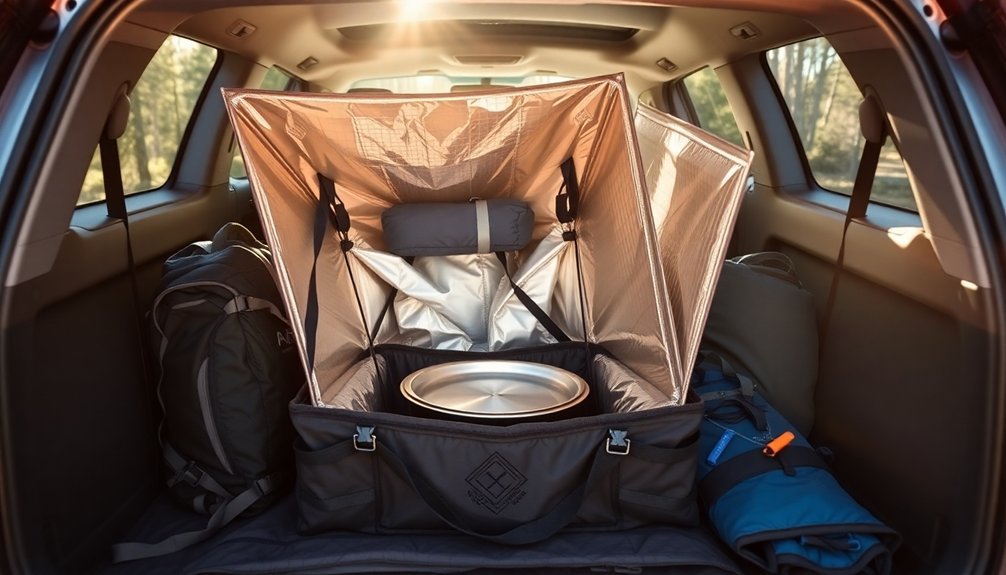
Proper storage of your solar oven guarantees its longevity and reliable performance throughout the seasons. Store it in a dry, protected location away from moisture and extreme temperatures. Before storing, clean all reflective surfaces and verify the windscreen and reflective coating are intact.
| Storage Area | Pre-Storage Tasks | Safety Checks |
|---|---|---|
| Indoor space | Clean surfaces | Test temperature |
| Covered patio | Secure loose parts | Check seals |
| Storage shed | Remove dust | Inspect foil |
| Garage | Pack insulation | Verify alignment |
| Climate-controlled | Tape components | Test efficiency |
You'll want to wrap your oven in a protective covering and secure any loose components with aluminum tape. Before each use, inspect for wear, clean thoroughly, and test the internal temperature with an oven thermometer to verify it's functioning correctly.
Protective Cases and Containers
Just as your solar oven needs protection, your off-grid cooking equipment requires reliable storage solutions to maintain its condition and functionality.
You'll want to invest in durable, weather-resistant containers that can withstand outdoor conditions while keeping your gear safe and organized.
Choose storage solutions that offer:
- Airtight seals to protect against moisture and pests
- Multiple compartments for efficient organization of utensils and tools
- UV-resistant materials to prevent degradation from sun exposure
- Stackable designs that maximize limited space
- Transparent sections for quick content identification without opening
When selecting containers, prioritize those with reinforced handles for easy transport and consider specialized options like knife cases or insulated coolers for specific equipment.
Don't forget about collapsible containers that'll save space when not in use, perfect for compact off-grid setups.
Emergency Backup Equipment
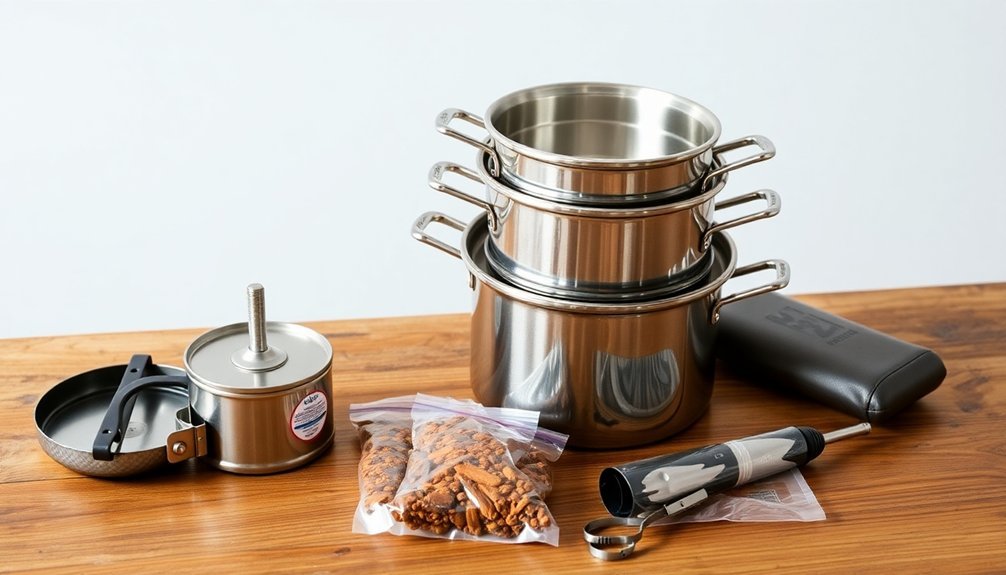
When power outages or emergencies strike, having reliable backup equipment guarantees you can continue cooking and preparing meals safely.
You'll need a UPS system or generator to power essential refrigeration units, ensuring your food stays fresh. Make sure to have them professionally installed and regularly serviced.
For cooking alternatives, you'll want portable butane stoves for indoor use and propane grills for outdoor cooking.
Keep a complete set of manual kitchen tools, including can openers and lightweight cookware like the StarFire Camp Stove. Don't forget an arc lighter for fire starting.
Store extra fuel, including butane canisters and propane containers, alongside non-perishable foods that need minimal preparation.
Label and date all food items, and maintain additional water supplies for rehydrating freeze-dried meals.
Mobile Kitchen Setup
When setting up your mobile kitchen, you'll want to prioritize a logical gear layout that keeps your most-used items within arm's reach.
Smart storage solutions, like stackable containers and wall-mounted organizers, can maximize your limited space while keeping essential equipment accessible.
Quick assembly becomes easier when you group related items together and use clear containers that let you spot what you need at a glance.
Essential Gear Layout
A well-organized mobile kitchen layout serves as the foundation for efficient off-grid cooking operations. You'll need to position your essential equipment strategically to maximize workflow while conserving space.
Start by mapping your cooking zone with crucial elements positioned for easy access.
- Place your griddle and range near the ventilation hood for proper smoke removal.
- Set up your prep station with cutting boards between the storage and cooking areas.
- Install your 3-compartment sink where it won't interfere with the cooking flow.
- Position your refrigeration units away from heat sources but within arm's reach.
- Mount your POS system near the concession window for quick service.
Remember to keep cleaning supplies accessible but separate from food prep areas to maintain proper hygiene standards while working in tight spaces.
Space-Saving Storage Solutions
Making the most of limited space in your mobile kitchen requires strategic storage solutions that maximize every square inch. You'll need to think vertically and utilize every hidden corner while keeping your cooking essentials accessible.
| Storage Area | Best Use | Space-Saving Tips |
|---|---|---|
| Vertical Walls | Magnetic strips, hooks | Mount utensils, knives, lightweight pots |
| Cabinet Doors | Slim racks, organizers | Store spices, foils, pot lids |
| Corners | Pull-out shelves | Stack cookware, pantry items |
Install clear, labeled containers to quickly locate ingredients, and opt for nesting cookware sets that stack efficiently. Use mobile carts that can slide between appliances, and don't forget to maximize under-sink spaces with expandable organizers. Consider wall-mounted shelving units that fold away when not in use, keeping your mobile kitchen clutter-free and functional.
Quick Assembly Tips
Successfully assembling a mobile kitchen requires careful planning and systematic execution. You'll want to start by evaluating your space layout and selecting multi-functional equipment that maximizes efficiency while minimizing clutter.
When you're ready to build, use proper tools for precise cuts and secure assembly.
Key steps for quick assembly:
- Cut all wooden components to size using a miter saw for legs and rails
- Drill pocket holes to create strong joints between pieces
- Install shelving units with sturdy supports and proper screws
- Apply protective sealant to guard against weather damage
- Add essential accessories like handles and latches for functionality
Remember to organize your work zones logically and create clear pathways for movement.
Install modular storage systems to keep cooking supplies easily accessible, and don't forget to add safety features for secure transport.
Efficient Gear Management
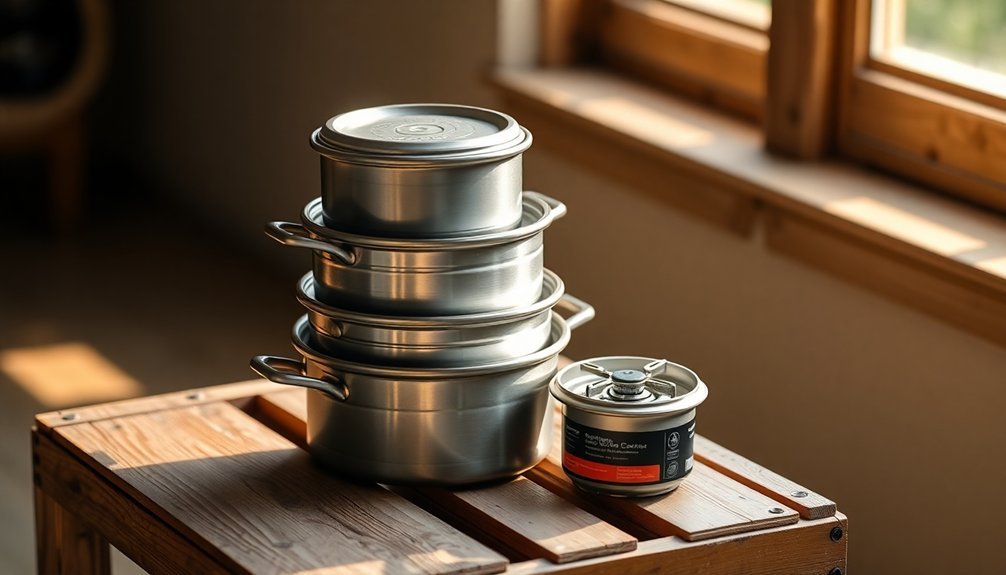
Proper gear management forms the foundation of a functional off-grid kitchen.
You'll maximize your space by choosing multi-functional utensils like the MSR Alpine Set, which combines a spoon, spatula, and grater in one compact package. Select nesting cookware sets, such as the Sea to Summit X Set 32, to minimize storage needs.
Organize your gear with a strategic mindset by investing in compact carry cases and utilizing vertical space.
You'll want to hang pots and pans when possible, and store your cooking tools in designated areas for quick access. Keep your food storage containers well-matched and sorted, using quality options like Mason jars for dry goods.
For perishables, a high-performance cooler like the Yeti Tundra will maintain freshness while you're off the grid.
Equipment Maintenance On The Move
When you're living off-grid, maintaining your cooking equipment becomes essential for long-term reliability and safety. Your gear needs regular attention, especially when moving between locations.
Make it a habit to inspect and clean your equipment after each use to prevent buildup and damage.
- Mix a solution of 75% water and 25% white vinegar to tackle stubborn grime on stoves and burners.
- Check fuel lines and connections for leaks before each use, paying special attention to propane tanks.
- Clean burner stems with a flexible venturi brush or hooked wire to remove debris.
- Apply a thin coat of olive oil or WD40 to protect metal surfaces from rust.
- Let all equipment dry completely after cleaning to prevent corrosion.
Remember to store your fuel supplies in well-ventilated areas and schedule professional inspections annually for peak performance.
Quick Assembly Storage Systems
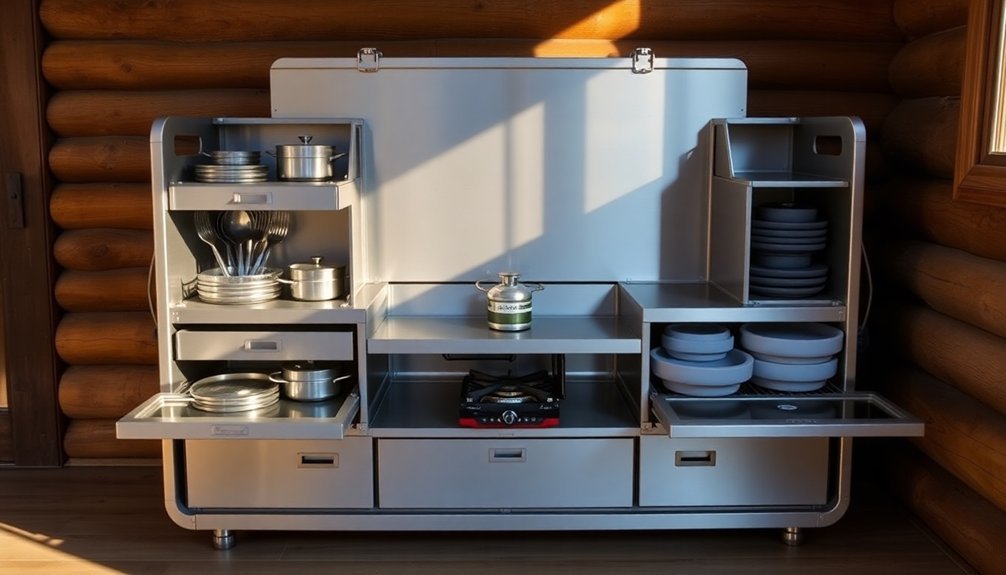
A reliable storage system forms the backbone of off-grid cooking operations. You'll find today's modular storage solutions offer tool-free assembly and remarkable durability, perfect for your mobile cooking setup. These units come in six sizes and don't require special equipment to put together, making them ideal for tight spaces and remote locations.
| Feature | Benefit | Impact |
|---|---|---|
| Tool-free Assembly | Save time and effort | More cooking, less setup |
| Stackable Design | Maximize vertical space | Triple your storage capacity |
| Weather-resistant Steel | Protected supplies | Peace of mind in storms |
| Quick-replace Panels | Easy maintenance | No long-term downtime |
You can customize these units for your specific needs, with options to stack them two units high outdoors or three units high indoors. Their self-supporting structure includes security features like cylinder locks, ensuring your cooking equipment stays safe wherever you go.
Frequently Asked Questions
How Do You Prevent Rodents From Accessing Stored Off-Grid Cooking Equipment?
Store your cooking equipment in sealed plastic containers, use peppermint oil deterrents, place traps nearby, and guarantee there aren't any food residues. Keep everything elevated and regularly check for signs of rodent activity.
What's the Average Lifespan of Solar Cooking Equipment in Frequent-Move Conditions?
If you're frequently moving, you'll get 5-10 years from your solar cooker instead of the typical 15+ years. Regular maintenance, proper storage, and careful handling during transport are essential for maximizing its lifespan.
Can Off-Grid Cooking Equipment Be Safely Stored in Extreme Temperatures?
You'll need ventilated storage for extreme temps. Don't keep propane equipment above 120°F or below -40°F. Your insulated carriers and thermal boxes will last longer when stored at moderate temperatures between 50-85°F.
How Often Should Fuel Canisters Be Rotated in Long-Term Storage?
You'll need to rotate your fuel canisters every 6 months for ideal safety and performance. If you've added fuel stabilizers, you can extend rotation to 12 months, but don't exceed this timeframe for best results.
Which Cooking Equipment Materials Are Most Resistant to Humidity Damage?
You'll find stainless steel and ceramic are your best choices for humidity resistance. They're non-porous, won't rust, and require minimal maintenance. Stainless steel particularly excels in moisture protection with proper drying.
In Summary
Pack your solar cooking gear thoughtfully, and you'll always be ready for off-grid meal preparation. Keep your equipment protected, organized, and easily accessible using modular storage solutions. When you're moving frequently, efficient storage systems aren't just convenient – they're essential for protecting your investment. With proper maintenance and smart packing strategies, you'll maximize both space and functionality in your mobile solar kitchen setup.





Leave a Reply